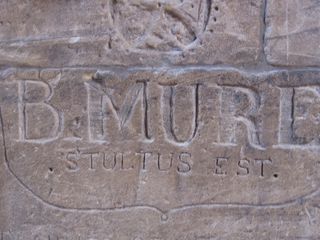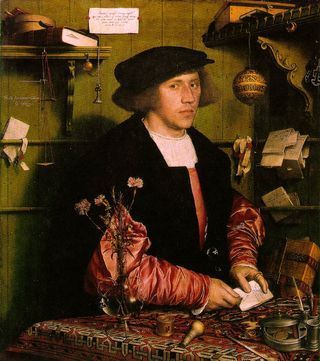The advantages of knowing Latin
Before we visited the temple of Philae (one of those moved and re-erected after the new Aswan dam), we spotted some interesting stuff in the Rough Guide. One of the bits of graffiti, it said, was written by a Roman -- because it was in Latin: "B Mure stultus est", "B Mure is stupid".
Hang on we thought. What kind of Roman name is B Mure. Either someone had copied the name down wrong, or sure as hell the graffiti wasnt Roman.
As you can see, the latter was the right answer. First B Mure had come along and scratched his name...then some Latin-ate nineteenth-century tourist, follower or enemy had come along later and written 'stultus est'... the Latin equivalent of 'B Mure is an idiot'.
So who was B Mure. Our guess is that it was Benoit Jules Mure (1809-1858) a "pioneer of homeopathy", who in the nineteenth century took homeopathy to Malta, Sicily and Brazil, before coming to Egypt and Sudan with his new medical science. If he went from Egypt to Sudan, then Philae would have been on his route.
So maybe the Latin graffiti-artist was a dissatisfied patient....rubbishing homeopathy as much as the practitioner.
Anyway, without any clue about Latin and Roman names, you'd be taken in by the Rough Guide. A small victory (ok, only a small one) for Latin. But it so happened that when I was in Egypt I was reading a book on portraiture . . . a good one, but it could likewise have done with a bit more Latin.
It was Shearer West's Portraiture (OUP) -- and highly recommended in general. But it starts with a portrait by Holbein of George Gisze, with an inscription on the back wall, or actually a piece of paper pinned up. West says a bit vaguely that it is written in a mixture of Greek and Latin and that it translates "The countenance which you perceive is an accurate image of Gisze".
None of this quite added up, and it wasnt much helped by the slightly garbled Latin text printed in the end-notes.
A hard look, and blowing up the picture on the laptop, showed for a start that it wasnt a mixture of Greek and Latin. The poem was headed "DISTICHON in imaginem Georgii Gysenii" (that is, "a two-liner on the painting of George G" .. though Holbein also seems to have garbled the Greek pretty badly. It then goes on, not to say that it is an accurate image, but "sic oculos vivos sic habet ille genas": literally "he has living eyes just like this, and cheeks"..(unless you think that "vivos" is for "vivus".. the "living man has..."). It ends with George's age (34) and the date.
Well OK maybe that does come down, more or less, to "accurate". But this is a book about portraiture for heaven's sake, and one of the things at issue is what is "lifelike" about a portrait, and which bits carry that verisimilitude. And that's what Holbein was going on about. It's kind of important.
Getting the Latin right would have helped.
Mary Beard's Blog
- Mary Beard's profile
- 4076 followers





